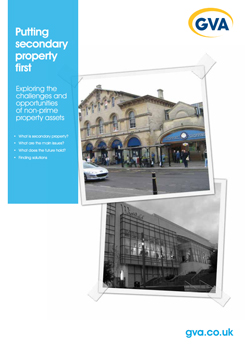Putting Secondary Property first - GVA
Report Authors: GVA
Report Summary:
Secondary property can be a huge problem. It has not benefitted from the recovery in values seen in the prime market over the last two years and a vast amount of outstanding debt is still secured against such assets, many of which have breached their financial covenants or are in a default position. With a slow recovery expected in the occupational markets, investors will continue to view secondary assets as risky. Recent coverage in the media reflects the significance of secondary property and includes the recent Southern Cross position, proposed asset sales by NAMA and Lloyds Banking Group’s Project Flagstaff portfolio sale. But secondary property is also an opportunity.
This bulletin explores the topic and addresses the following key questions:
• What is secondary property?
• How bad is the current situation?
• What is the outlook for this part of the market?
• What are the solutions?
The Current View:
Secondary property is hard to define as it covers a large and diverse range of properties. What’s more, the boundary between prime and secondary property fluctuates with the market.
Despite this, it is a vital area to explore, particularly for funding institutions in the light of the recession: a large proportion of outstanding debt is secured against secondary property. This bulletin takes a broad view of secondary property, looking at the current and likely risks and opportunities for those holding such properties.
Secondary property has not benefitted from the recovery in values enjoyed by the prime market over the last two years. A vast amount of outstanding debt is still secured against such assets, and many have breached their financial covenants or are in a default position. Investors consider secondary assets as risky because:
• they are management intensive, capital
intensive and potentially obsolete
• they are also more prone to voids and
loss of income, covenant strength is
weaker
• they are often over-rented with rental
values still falling
• due to ever shorter leases it can be
a challenge to re-let buildings when
leases expire or break clauses take
effect
• it is particularly hard to secure bank
debt against
About the Author:
GVA’s award winning Research team provides high quality research and analysis to the business and its clients. Our market commentaries, thought leadership pieces and consultancy advice drive industry debate, distinguish GVA from its competitors, and add value for our clients.
